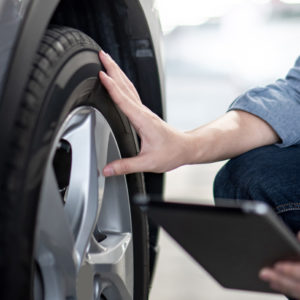Did you know that you can have the sports-car look without having to buy an actual sports car? One of the key features that give sports cars their sleek look is their low-profile tires. While replacing your regular tires with low-profile tires won’t make your vehicle look exactly like a sports car, it’s certainly a great place to start if you want to spice up your ride.
What Are Low-Profile Tires?
Also known as “low-pro tires”, low-profile tires have an aspect ratio of 50 or less, which means they have shorter sidewalls than regular tires. To make this easier to understand, why don’t you take a look at your own vehicle’s tires?
You should notice a code written on the side of your tires that looks something like this: P235/40 R18. The letter “P” indicates your vehicle is a passenger vehicle, while the number beside it refers to your tire’s section width. The number after the slash refers to the aspect ratio, and the number after “R” refers to your rim size.
Since this example has an aspect ratio of 40, it’s a low-profile tire with a narrower sidewall. These numbers might not seem like much, but they make a big difference when you’re the one behind the steering wheel.

Advantages of Low-Profile Tires
As you think about buying low-profile tires, you’re probably asking yourself an important question: Are low-profile tires actually good? Well, the answer really depends on what you’re looking for. Consider some of their advantages:
Appealing Appearance
Everybody knows looks are subjective, but most people agree that low-profile tires look more stylish and eye-catching than most tires. Their wider look and larger rims give vehicles the edgy look of high-end sports cars.
Better Handling
The great thing about low-profile tires is that they don’t just look good. They make driving feel good too. Low-profile tires have stiffer sidewalls, which means they don’t flex as much as regular tires whenever you make sharp turns.
You can also expect better traction when driving on dry and smooth surfaces because of these tires’ wide tread blocks.
Shorter Stopping Distance
Another great advantage low-profile tires have over regular tires is their shorter braking distances. Low-pro tires take up less space, which means your vehicle will need larger rims to fill up all of that free space.
Larger rims mean there’s more space in your vehicle for bigger braking hardware if you want to install new ones. A bigger braking system gives you more stopping power and reduces your braking distance, which can be especially helpful whenever you’re driving fast.
Increased Fuel Efficiency
If you’re looking for a way to save on gas, then you might want to consider getting low-profile tires. Thanks to their shorter sidewalls and simpler tread design, low-pro tires have lower rolling resistance than regular tires, which contributes to better fuel economy, even at higher speeds.
Improved Run-Flat Technology
Have you ever been stranded somewhere because of a flat tire? It’s a frustrating experience, especially if you’re left with no choice but to call a tow truck. With the right kind of low-pro tires, you could say goodbye to all of that.
Because low-pro tires have less pressure, it’s easier for manufacturers to install run-flat technology on them. Not all low-profile tires have run-flat technology, but those that do will let you drive your vehicle for around 50 more miles, even with a flat tire.

Disadvantages of Low-Profile Tires
Unfortunately, low-profile tires aren’t all sunshine and rainbows. They come with their fair share of disadvantages too.
Increased Road Noise
Road noise isn’t just about the noise your tires make when they roll across the asphalt. It’s also about the air passing through the grooves of your tires. This is why low-profile tires, which have more grooves due to their wide contact patch area, make much more road noise.
Because low-profile tires have more grooves, more air passes through them, creating more noise when you drive around. This isn’t an issue for most people, but if you enjoy quiet car rides, then it’s something you should consider.
Poor Grip on Uneven Surfaces
Do you often pass by dirt roads? Because if you do, then you might want to think twice about getting low-profile tires. Low-pro tires have stiff treads, so they won’t have a good grip on uneven surfaces. So while low-profile tires are great for regular road use, they’re not the best choice when off-roading or driving on icy roads.
Bumpier Ride
If you’re looking to replace your tires with low-profile ones, then you’re in for a bumpy ride. A tire’s sidewall absorbs most of the impact from driving over bumps and potholes, but because low-pro tires also have shorter sidewalls, they won’t absorb as much shock as regular tires do.
Are Low-Profile Tires Prone to Bursting?
In certain circumstances, yes, low-profile tires are prone to bursting. Because there’s less cushion between low-pro tires and the road, there’s a greater risk of wheel and rim damage when you drive over bumps, potholes, and other sharp objects on the road.
How Long Do Low-Profile Tires Last?
Like most performance tires, low-profile tires also tend to wear faster. Their softer compounds might provide better traction, but this also means their rubber will wear out faster than regular tires.
Of course, this doesn’t mean your low-pro tires can’t last for a long time. In the end, how long they last will still depend on several factors. If you don’t overload your vehicle or rarely pass by uneven roads, then you can expect your tires to last around 40,000 miles.
Any information provided on this Website is for informational purposes only and is not intended to replace consultation with a professional mechanic. The accuracy and timeliness of the information may change from the time of publication.



























